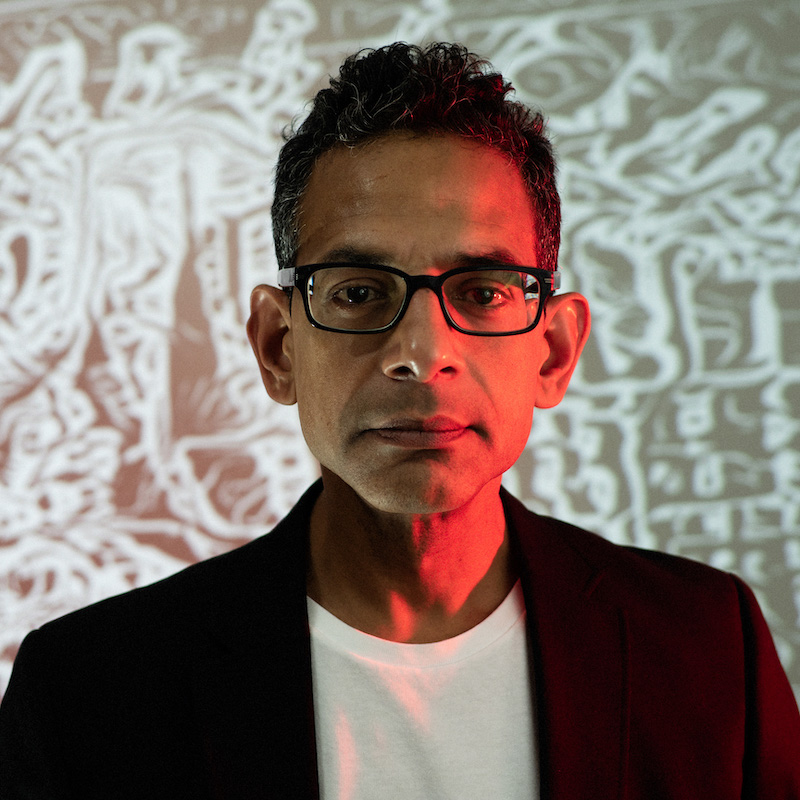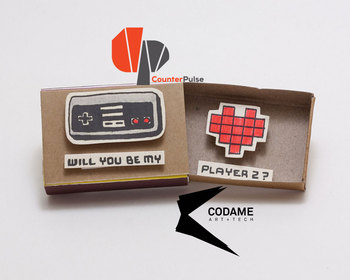Gary Boodhoo is an interface designer and game developer whose creative practice uncovers emotional connections with smart objects in social spaces. “I glimpsed the Self within the computer and wondered if others would see it too", Boodhoo ventures. He describes his current work as science fiction cave painting owing to its spontaneous creation of ritual imagery.
His work has been featured at the Game Developers Conference, Stanford Linear Accelerator and California Academy of Sciences. Since 2018, his workshop series, Make Art with AI has introduced participants to the robot uprising through hands on experience and play.
Interview with Gary Boodhoo
CODAME Featured Artist Gary Boodhoo is an interaction designer who draws on his digital training as well as a longtime fascination with psychedelic experiences to create his artworks. Under the label, DeepDreamVisionQuest, he explores the nature of games and perception, producing what he refers to as “science fiction cave paintings.” Recalling the ancient images at Lascaux, this term is one way to describe the primal human expression he seeks to make possible using cutting edge visualization technology.
In my recent conversation with Boodhoo, we discussed his technical background and the multiple threads of inquiry that led him to DeepDreamVisionQuest. We also examined the aesthetic and intellectual challenges that inevitably occur when enlisting artificial intelligence and machine learning in creating original artwork.
A Starting Point in Computational Graphics
Boodhoo has been using computers to program or perform art since his first machine in 1979 (a TRS-80 Model 1). As a digital designer, Boodhoo has been creating visual graphics and interfaces for over two decades. A lifelong student and practitioner of interactive media, he studied Computer Graphics, Interactive Media, and Performance Art at the Massachusetts College of Art.
He was drawn to music as a child, but he also had an early interest in computer graphics, and he excelled at drawing. While he enrolled in art school with the intent of practicing illustration, he says, the “musical way of thinking” never left him, and he frequently returns to music as a metaphor or method for exploring ideas.
Once enrolled at MassArt, he followed the most interesting people he could find, which led him to the The Studio for Interrelated Media. While there, he gained a deep education in multimedia art practices and history, often learning firsthand from the other students and faculty around him. Some of them had been working with computers in art since the 1960s, decades before they were mainstream. Before long, he says, “I was spending most of my time, sometimes even sleeping, in the computer lab.”
After graduation, he began his career in digital graphics. “I was a broadcast designer, where I worked in local Orlando TV, The Golf Channel, and at post production boutiques in Atlanta, doing motion graphics,” he says. Around 2000, though, the work dried up. Once again, interesting people helped point him in the right direction, when some friends at Electronic Arts tapped him to work on sports games.
That move turned out to be fateful. Though Boodhoo’s experience creating real-time graphics for sports broadcast was only superficially related to his new game design work, he found himself pondering some fundamental questions about what he was making: “How are people responding to and interacting with graphics?”
The switch from broadcast to interactive design was an important jump from creating data displays (infographics for decoration or advertising) to creating interactive displays that that directly affected players moment to moment. “I started thinking a lot about player reactions to responsive graphics and how user interfaces supported the larger narratives of the games we were making,” he says. “I’ve been hacking that problem for some 20 years with no end in sight. Humans are complicated.”
Ultimately, the problem of designing game interfaces often rests on a single, simple question: “What is the smallest bit of [visual] information I can give you that’s meaningful, and that expands into a greater meaning?”
This question continues to resonate throughout his work.
Discovering Deep Dream
As a learner, Boodhoo is curious, voracious, and highly self-directed. Embarking on his game design career, he realized that programming was often the best way to show and tell, and threw himself into improving that skill. Similarly, when he first encountered Deep Dream, a computer vision program created by a Google engineer named Alexander Mordvintsev, he was hooked and quickly driven to learn everything about it.
“About two years ago, I started seeing this Deep Dream imagery on the internet. Honestly, it blew my mind,” he says. He was immediately struck by the way Deep Dream images seemed to illustrate the impossibly surreal visions that one might have during a psychedelic experience.
“I had no idea how it was made. I didn’t know much about machine learning at the time. …I dove deeper. I especially appreciated resources like GitHub, which is such a vital repository of technical knowledge, encouragement and workarounds during this time.”
The Deep Dream software was originally developed to visualize the internal states of neural networks used for classifying images. Boodhoo describes Deep Dream as “an amplifier.”

“A neural network is a bit of a black box,” he says. “It’s not that any one neuron is difficult to understand, it’s just a linear equation, but imagine a million neurons working together. That’s more than the human mind can understand. These engineers started creating tools to look inside neural networks and see what they were doing. DeepDreamVisionQuest came out of that.”
When asked to describe the process more precisely, Boodhoo says,
“Instead of putting an image in and getting an answer, we listen to the signals. Neural activity is drawn on top of the picture that caused the activity. Next, we present the network with this new picture, creating a feedback loop. This ends up exaggerating any features it detects.”
The result of this process, he explains, is nothing short of incredible. “The software doesn’t generate fully realized images all at once. Instead the neural network dreams repeatedly, building an image from statistics. It’s similar to imagining faces and other shapes in clouds. It’s just noise, but our tendency to see patterns is overwhelming and self-reinforcing.”
While the software creates feedback loops by exploiting and manipulating what is occurring in the neural network, an artist like Boodhoo skillfully influences this process of reverse engineering images, to create subtle and varied outputs.
Boodhoo raises the level of complexity by adding real time interactivity into his installations with a webcam. Participants are able to approach the camera and provide live input for the software, then watch their images transformed on a screen.
“These networks are deterministic,” Boodhoo points out. “If I just take one image, just a photograph, and run it through [the software], I’ll always get the same result. I can change the parameters and I’ll get different results, but…it’s just an effect. I realized I needed to show it something unpredictable, and that’s why I added the camera.”
Because live video will never provide the same image twice, the output is always changing, creating an unending stream of machine-hallucinated live imagery. The addition of the camera also brings a game-like quality to the experience.
“I wouldn’t really call it a video game,” Boodhoo says, “but some people really anticipate and lead it in ways I myself am unable to.”
For Boodhoo, the most enjoyable video games are those without clear points, winners, or losers — games that present intriguing interactive experiences and ask, “What if?” By this definition of a game, DeepDreamVisionQuest certainly qualifies.
Science Fiction Cave Paintings
Boodhoo began to think about his work as “cave painting” after he realized that the imagery was resonating with viewers and participants in a visceral way.
“The imagery was not new,” he says. “It was ancient. I enjoy Jungian psychology quite a bit, so I started thinking about archetypes and collective consciousness. I came to realize that these things aren’t being generated by the computer. Instead, we’re creating poetry together. You complete the circuit.”
When viewers first encounter Deep Dream-generated images, one of the most common reactions is to liken the images to a drug trip. Boodhoo does the same, and yet, he questions whether that reaction is in itself “an initial non-acceptance” as an almost defensive psychological reaction: it can be tempting to dissemble, to blame something external, like an intoxicant, for what one sees, but hallucinogenic drugs often serve to uncover images that already exist in the mind, not wholly create them.
“To dig deeper than that,” he continues, “Why these images? Why is this one leading to that one? Why does this one creep me out while another makes me laugh? As a designer, most of what I do is inception: reducing ideas to easily graspable forms. I began to see the memories represented in neural networks as a kind of universal language.”
When asked about the state of technology, and the way artists will incorporate AI into creative practice, Boodhoo is optimistic.
“I think of cave paintings, and I think of people taking a torch, huddling, crawling into a very inaccessible place that opens up and becomes a holodeck…so to speak.”
It’s an inspiring, dream-like vision.









